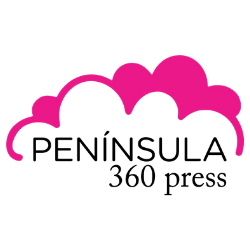Por Irma Gallo
Fotografía Manuel Ortiz Escámez
Creado en 1999 como un cuerpo policial para controlar las protestas de movimientos cocaleros en el norte de Colombia, el Escuadrón Móvil Antidisturbios (ESMAD) lleva la impronta infame de ser responsable de ataques directos contra manifestantes que han dejado como saldo más de 300 personas gravemente heridas desde 2019.
El sello distintivo de esta represión son los disparos, con balas de goma, directamente al rostro de las personas con la intención de provocar heridas graves en los ojos, que en muchos casos (sobre todo, pero no exclusivamente, a quienes pertenecían a las Primeras Líneas1 en las manifestaciones) causaron la pérdida del órgano o de la vista.
El 23 de noviembre de 2019 un agente del ESMAD disparó contra Dilan Cruz, estudiante de 18 años de edad, quien protestaba para exigir garantías por parte del gobierno para el acceso universal a la educación superior. El proyectil que impactó la parte trasera de su cabeza estaba fabricado con un material textil relleno de perdigones de plomo. Tras su muerte, se convirtió en un símbolo de la lucha contra la represión oficial.
En 2021, Cristian Zárate, víctima de uno de estos atentados, creó el Movimiento en Resistencia Contra las Agresiones Oculares del Escuadrón Móvil Antidisturbios (MOCAO).
En los albores del nuevo gobierno encabezado por el presidente Gustavo Petro y la vicepresidenta Francia Márquez Mina, en el que muchos colombianos han puesto su esperanza para una verdadera transformación en materia de derechos humanos, estos son los testimonios de algunos de los miembros del MOCAO, recabados en Bogotá, a finales de mayo de 20222.
Cristian Rodríguez Zárate
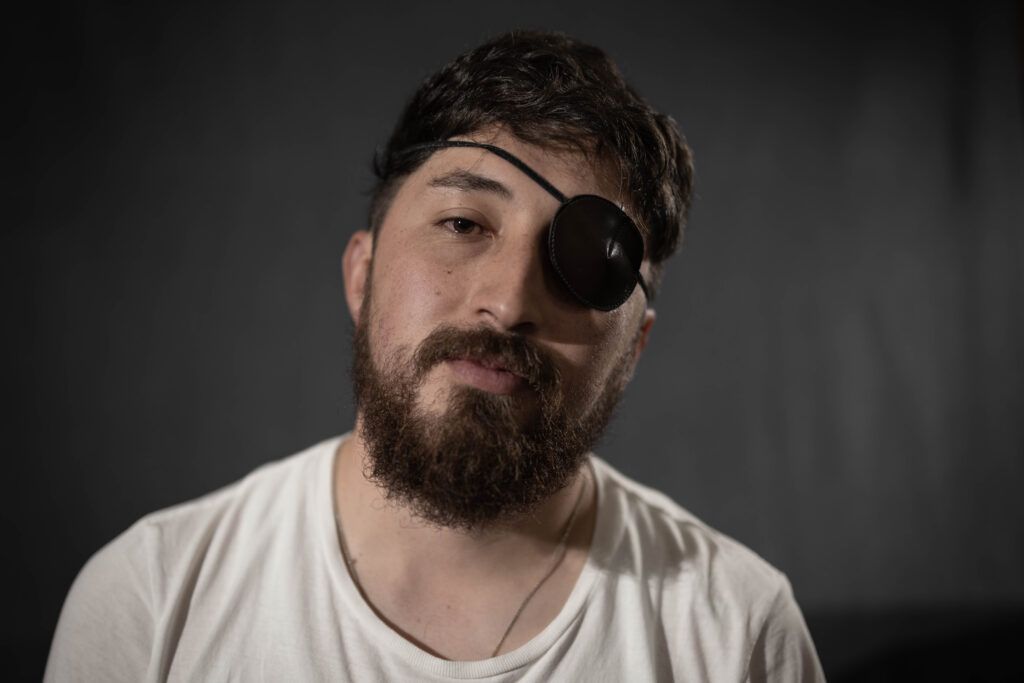
Desde mi punto de vista crítico, desde mi reflexión e indignación y también desde el sufrimiento, de que en Colombia no hay garantías para la vida, no hay derechos fundamentales, esto me lleva a sumarme a los movimientos sociales y a realizar activismo en las calles desde hace seis o siete años.
En el paro nacional del 21 de noviembre del 2019 se empieza a iniciar todo este fenómeno del abuso policial. Y dentro de ese concepto de abuso policial hay varios tipos, y uno de esos son las agresiones oculares. Ya en 2019, 2020 y 2021 se hace público y se hacen muy visibles este tipo de agresiones en las manifestaciones por parte de la fuerza pública.
Mi caso personal fue en el año 2019, exactamente el 16 de diciembre. Sucedió en la Universidad Nacional de Colombia, en la sede de Bogotá. Yo me encontraba concentrado en una manifestación que íbamos a hacer en la Plaza de Bolívar, en el centro de Bogotá, con varias organizaciones, movimientos estudiantiles, movimientos obreros, sindicalistas.
Sobre las 3 de la tarde partimos de la Universidad Nacional hacia la Plaza de Bolívar y ahí nos encontramos con muchísimas organizaciones, con la bancada de oposición del Congreso de la República. Duramos aproximadamente dos, tres horas y sobre las 5 o 6 de la tarde nos ordenaron evacuar.
La policía nos dijo a todos que nos fuéramos de la Plaza porque iba a haber un evento navideño, así que decidimos devolvernos otra vez a la Universidad Nacional y ahí, sobre las 7, 7:15 de la noche, en la entrada principal de la Universidad empezaron a haber confrontaciones entre el Escuadrón Móvil Antidisturbios (ESMAD) y los manifestantes.
En ese momento yo me encontraba en lo último de la manifestación; iba ingresando y cuando ya iba sobre la entrada siento… primero escucho un estruendo y después siento un impacto en la parte izquierda de la cara. Soy consciente de la situación e inmediatamente me doy cuenta de que pierdo la vista del ojo izquierdo. Me toqué la cara, tenía mucha sangre; empecé a pedir auxilio. Los medios de enfermería, los boy scouts, ellos me auxiliaron; me llevaron rápido a un hospital cercano, que es la Clínica Mederi.
Ahí estuve tres, cuatro días interno y después de salir del hospital comencé todo un proceso de recuperación en lo psicosocial, en el tema jurídico, el tema personal. Entonces comencé a demandar y a visibilizar este tipo de ataques.
A inicios del 2020 empecé a conocer a muchas personas que fueron agredidas también en uno de sus ojos por medio de una ONG que se llama el Centro de Atención Psicosocial. Comencé a conversar con los muchachos, empezamos a intercambiar experiencias, puntos de vista sobre lo que nos sucedió y llegamos a una gran conclusión y a «¿por qué no nos organizamos y denunciamos este tipo de ataques, no sólo desde las demandas individuales que hacemos sino a través de un colectivo, un movimiento?»
Tomamos esa decisión por lo que estaba sucediendo en Chile en 2019, ese movimiento tan vasto que hubo de víctimas de trauma ocular, más de 600 personas, algunas de las cuales quedaron sin vista.
En el año 2021, exactamente el 9 de abril, que en Colombia se conmemora el Día Nacional de las Víctimas, salimos a hacernos públicos, no sólo a través de un evento que hubo en la sede de Naciones Unidas aquí en Bogotá sino también en las redes sociales. Comenzamos todo ese proceso de visibilización con una tarea muy importante y muy grande, que es convocar y juntar a todas las víctimas de trauma ocular de todo el país.
Yo creo que esto es lo más complejo y lo más de largo aliento que hemos tenido que hacer: convocar chicos de la costa, chicos del eje cafetero, del sur de Colombia, de Cundinamarca.
Hablando del objetivo general: básicamente es, que a través de las acciones políticas, judiciales, artísticas, culturales, se empiecen a generar reformas, fallos, reestructuraciones, para que en un largo plazo se pueda generar el desmonte y la desaparición del ESMAD dentro de la fuerza pública.
Este movimiento me ha generado una motivación muy grande, también una estabilidad emocional y una iniciativa no sólo para buscar esa reparación simbólica que queremos sino para también reencauzar el estilo de vida que no sólo yo, sino todas las personas que sufrieron este tipo de ataques, llevaban antes de la agresión.
Este tipo de ataques son actos de lesa humanidad, someten a la persona a una tortura sistemática en todos los ámbitos de su vida: en lo laboral, en lo personal, en lo emocional. Se generan todo tipo de cambios fuertes, de alto impacto en su vida. Entonces, la esencia de este movimiento es traducir, y darle otra lógica, otra perspectiva, a este tipo de agresiones.
A las personas que sufren estas agresiones las someten a un luto, las someten a un duelo; hemos visto rupturas familiares, intentos de suicidio. Todo el tema de la salud mental queda bastante afectado.
Entonces MOCAO le da como esa vuelta de detener esa perspectiva del dolor y el sufrimiento a una perspectiva de resiliencia, de que hay un nuevo estilo de vida, otra forma de afrontar y de asumir las cosas para llevar no sólo una vida estable como seres humanos sino también como parte de este movimiento.
Lo que buscamos es justicia porque esto es bastante visible y está bastante claro que este tipo de agresiones son sistemáticas. Esto está preparado, hay todo un manual para generar este tipo de agresiones.
MOCAO en mí ha sido mi balanza; yo tengo una teoría muy bonita que es la teoría del trampolín: este tipo de situaciones, de momentos que uno vive, para mí son un impulso para seguir arriba, en donde siempre me he mantenido. MOCAO para mí ha sido ese símbolo de resiliencia y de unidad, y también de resistencia para todo lo que hemos hecho hasta el momento y lo que nos toca hacer más adelante.
Daniel Alejandro Jaimes

Ese día fue bastante fuerte. Se formó un tropel en la localidad bastante grande. Fue el primero de mayo de 2021. Estábamos con unos amigos; había mucha presencia de la policía, había ESMAD. Incluso esa tarde yo fui a acompañar a una chica y en una parte me alcancé que ya se estaban poniendo sus chalecos, se estaban alistando los manes y entonces en ese momento me dio muchísima rabia.
Hubo mucha concentración. En ese momento el paro estaba con todas las fuerzas posibles y entonces nosotros, con esa alegría de todo lo que estaba pasando ese día, estábamos pasando un rato chévere, un rato bacán con los amigos.
Al momento que íbamos subiendo alcanzamos a ver que había muchísima fuerza disponible y estábamos listos con nuestros escudos. Cuando llegamos al cruce pasaron 20, 30 segundos y empezaron a tirar gases; entonces la gente corrió. Empecé a ver cómo niños y sus padres iban corriendo de la mano y eso me generó mucha rabia.
Ese gas es muy fuerte, así que me puse una bufanda y la capota porque había un dron tomando fotos. Me tapé muy bien la cara.
La gente ya estaba muy ofendida. Los gases los tiraban al cuerpo, completamente. Pasaron más o menos 15 matrimonios (o sea, parejas formadas por un policía y un oficial del ESMAD) que iban con sus escudos y unos con el lanzagranadas.
Al momento que vimos eso, dijimos: donde nos cojan en la principal no tenemos dónde correr, así que hicimos una barricada con contenedores de basura que son como de dos metros, más o menos. Todas las balas de goma pegaban en el contenedor.
Me quedé viendo a un oficial por la izquierda; al momento que me lo quedé mirando así veo una ráfaga del lado derecho, entonces mi reflejo fue voltear. Al momento que volteé, me impactó en la nariz. Yo digo que por ese reflejo no perdí la vida.
Al momento que dispararon sentí como si fuera el flash de una foto. No sentí ningún dolor, pero me caí sobre los codos y escuché ¡pum! Sentí que alguien me agarró de los brazos y me empezó a arrastrar. Después llegó otro chico y me arrastró de las piernas.
El del ESMAD estaba recargando nuevamente. Hubo un espacio para que a mí me jalaran y no me llevaran ellos. La herida fue bastante grande. En ese momento caí aturdido y lo vieron, me dispararon. No reaccionaba. Cuando reaccioné me toqué los dientes con la lengua y sentí que estaban rotos; me ofendí muchísimo, me enojé bastante.
Sentí que la nariz se me tapó. No podía respirar. Tenía mucha sangre en la nariz. Me llevaron a la estación de bomberos en una rejita. Ahí me atendieron. Me estaba ahogando con mi propia sangre.
Al momento llegó la ambulancia. Yo no sabía bien qué había pasado. Sentía tapada la nariz y se me hincharon mucho los párpados. Abrí los ojos y alcancé a ver que llegué al hospital.
Pasé cuatro días muerto en vida porque no se sabía a ciencia cierta qué había pasado conmigo. Me cortaron las camisas, tenía el pantalón lleno de sangre y sentía sangre en la cabeza, en los hombros, me llegaba al torso.
Estaba muy deshidratado y lloraba por un vaso de agua, pero no daban porque no sabían si me iban a operar al otro día. La enfermera a escondidas trajo unas gasas con agua y me tocó espicharlas para al menos tomar agua.
Al tercer día me quitaron las vendas y me dijeron: «bacan, ¿alcanzas a ver algo?» Vi un azul, como una escala de grises, muy oscuro, y alcanzaba a percibir luz. En ese instante tuve la esperanza de que iba a poder seguir viendo.
Con el tiempo fueron mirando los daños y no fue sólo el ojo, fueron también 10 piezas dentales, desprendimiento de maxilar superior, y la nariz. En ese momento vieron que tenía una hemorragia en el ojo izquierdo y tocaba controlarla, pues podía perder el ojo izquierdo también.
En el ojo derecho me dijeron que el impacto estalló la retina. Estuve un mes hospitalizado. La estancia en el hospital fue muy dura. A mi mamá le tocó acostarse en un sofá por un mes. De estar acostado, yo tenía estrías en la espalda.
Mi visión era muy corta, como de aquí a donde tú estás. Había un televisor y no lo alcanzaba a mirar. Después, con el tiempo fui dando un desarrollo muy bueno y alcancé a aclarar muchísimo la vista.
Pero nunca perdí la compostura. Siempre me mantuve alegre, siempre me reía con mi mamá. No caí en una pena moral, no me puse triste porque sentía que mi familia estaba ahí.
Es complejo acostumbrarse a mirar con un solo ojo, hacer cosas con un solo ojo: tú quieres agarrar algo y está un poquito más lejos, entonces pierdes esa profundidad.
Me di cuenta de MOCAO por un canal de televisión. Mi tío me dijo: «Dani, venga rápido»; yo le dije: «¿qué pasó?», y pues estaban hablando de MOCAO, de qué trataba el colectivo. Y tuvimos contacto con Cristian.
Me genera muchísima fuerza. Siendo parte del MOCAO todos tenemos esa voz y ese voto. Estamos muy pendientes de los chicos. MOCAO no se convirtió en un colectivo nomás para mí; se convirtió en una familia. Con Cristian hablamos bastante, nos reímos y más de una vez nos encontramos en muchos espacios, entonces se genera una confianza bastante bacana.
Una vez un chico llegó y me dijo: «Parce, no sé, estar con ustedes me da muchísima fortaleza«».
Solo nosotros sabemos el dolor que hemos pasado.
Gareth Sella
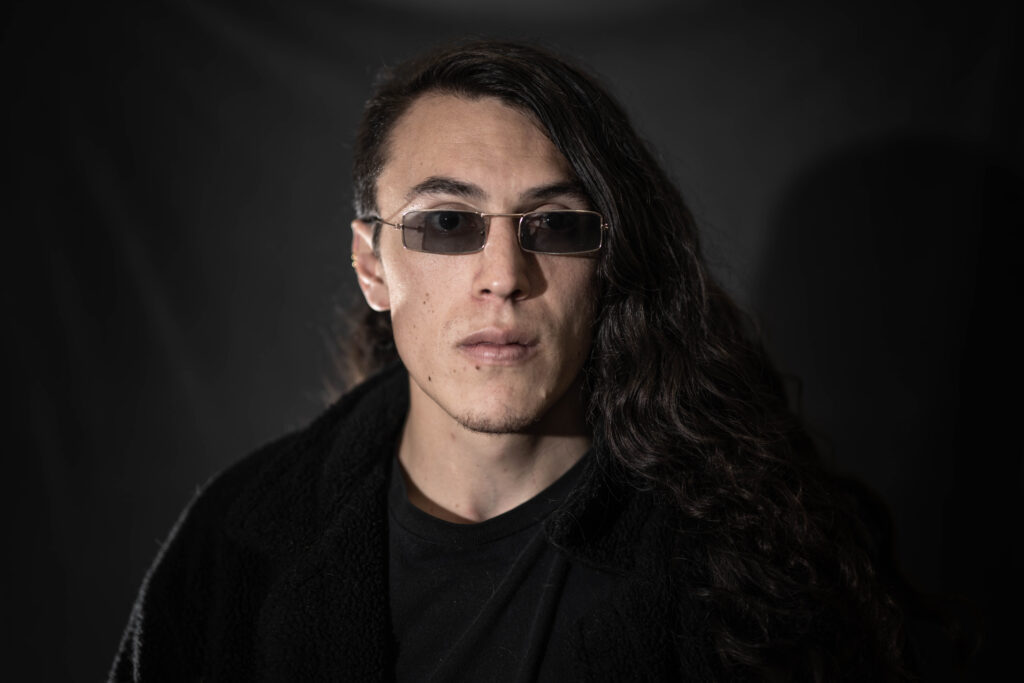
No es que haya sido una experiencia sino que sigue siendo una experiencia. Al menos yo voy para un año y sigo descubriendo muchas cosas aún, aceptando muchos sentires, muchos dolores, muchos cambios.
Pero puntualmente el hecho, que ni siquiera empieza en el momento en que me disparan sino que yo hacía parte de una primera línea que se llama Escudos azules, empieza unos días antes, cuando la inteligencia de la policía de acá saca una alerta criminal interna tachando a Escudos azules como un grupo radical y violento que estaba convocando a destrozos el 24 de febrero.
Sacan esa alerta el 22 de febrero, el 23 nos la filtran a nosotros y ese día hacemos la denuncia pública. El 24 de febrero, el día de la movilización oficial contra la brutalidad policial, un policía en radio dice: «no, la alerta era cierta pero nosotros los conocemos y no, ellos son pacíficos y nos gustaría un día hablar con ellos». Y unas horas después, me disparan.
Ya estaba esta estigmatización, este señalamiento, esta forma de volvernos un objetivo.
El momento en que me disparan es en el centro de Bogotá, en la Carrera Séptima con Calle 23. La intervención se da en la calle 24, viene un escuadrón del ESMAD, empieza a dispersar la movilización que no era muy grande, eran 200 personas, pero en ese momento todo el mundo se estaba yendo, o sea, no había un enfrentamiento, yo me estoy yendo y mientras me trato de retirar, en la siguiente cuadra, en la 24, me doy la vuelta y desde atrás es desde donde me disparan.
Me disparan tres balazos de marcadoras, que son las balas de goma, que me dan en la cabeza, en el ojo y al lado de la nariz.
Y lo que sigue es un montón de estigmatización, amenazas, seguimiento, reivindicación, seguir peleando, conocer un montón de gente que sigue peleando, que sigue luchando, aceptar lo que pasó, dolerse, etcétera.
Hoy estoy haciendo televisión. Me he graduado hace tiempito, en el 2019, en abril, y antes de salir de mi carrera yo había formado una productora con unas compañeras de la universidad. Desde antes mi trabajo siempre ha sido audiovisual.
En un principio, cuando me disparan, duré 60 días en cama. Porque tengo una primera cirugía, luego otra cirugía, y resulto con una incapacidad final de 60 días.
También lo que pasa cuando a uno le disparan es que hay una estigmatización muy fuerte, entonces uno tiene que cambiar la narrativa, luchar contra esa narrativa porque uno no puede dejar que ellos definan qué es lo que es uno.
Es una criminalización de los procesos sociales. Es decir, ellos han criminalizado el pertenecer a la Primera línea.
Visualmente no se nota tanto el disparo pero hay muchos chicos a los que se les nota mucho, y entonces hay una marca y es una forma en que la gente los señala y también es muy difícil encontrar trabajo.
Entonces no sólo es la violencia del hecho, que se le llama trauma ocular no solamente por el golpe, sino por lo que genera, que es una marca para toda la vida que te dificulta tener acceso al derecho al trabajo y otros lugares.
La Primera línea es una manifestación popular que también se da en otros lugares: en Chile, en Hong Kong, en diferentes espacios del planeta frente a la represión policial. Aquí se viene dando sobre todo desde el 2019.
[A partir del asesinato de Dilan Cruz, en noviembre de 2019] necesitamos defender a la gente, necesitamos alguien que nos defienda porque en ese momento yo no hacía parte de las Primeras líneas.
Aparecen un montón de chicos a lo largo de 2019 y todavía más fuerte en el 2021 que dicen: vamos a ponernos cautos porque nos están disparando en la cabeza. Vamos a ponernos gafas porque nos están disparando a los ojos. Vamos a ponernos máscaras de gas porque nos están gaseando y además con diferentes tipos de gases; no solamente es un gas lacrimógeno, sino que es el gas lacrimógeno vencido de hace ocho años, diez años, que es más perjudicial para la salud.
Usamos escudos porque nos van a querer golpear, porque nos van a disparar con todo, con gases, con aturdidoras, con balas de goma.
Nosotros no estábamos formándonos en nuestra vida para cubrir un escudo; estábamos haciendo otras cosas, queríamos otras cosas y es tanto ese dolor de ver a los compas que les disparan y los matan.
La policía acá es casi una policía militar. No hace parte del Ministerio de Defensa pero se forma militarmente con una lógica del enemigo interno que tiene que ir a enfrentarse contra insurgentes, contra guerrilleros, etc., entonces hay una estigmatización muy grande contra quien se manifiesta.
Persiguen a la gente hasta en los hospitales. A mí me llegaron tres agentes de la inteligencia policial cuando estaba medicado. Y eso lo hacen con muchos: van y se pasean allá afuera, como haciendo una presión bien violenta para amedrentar.
Y aquí estoy, con un ojo. Prácticamente sin un ojo, aunque yo no lo perdí, lo que perdí fue mi visión, pero es como no tenerlo. Es difícil, complicado al principio.
Para mí [estar en el MOCAO] ha sido un proceso curioso y extraño porque cuando me disparan me propongo cambiar esa narrativa. Inicio un trayecto muy delicado y muy solitario. A veces es más fácil tener un proceso en solitario pero que no va a llegar más lejos, y empieza a ser duro porque resulta muy difícil ver que estas cosas siguen pasando, ver que aparecen más chicos, más chicas, etc., y entonces el cuerpo genera una distancia, un poco como no quiero sentirme en ese lugar porque me es muy duro aún enfrentarlo.
Entonces, en un momento me es difícil involucrarme rápidamente. Es difícil sentirse identificado con un montón de gente y uno lo enfrenta en un momento tratando de decir «no me pasó, no fue tan grave». Pero llega un punto de decir: «sí me pasó y hay un montón de gente que le pasó y que la sigue pasando mal», y es otro lugar de lucha, y hay que luchar, y juntarse, y construir desde ahí, que es mucho más provechoso para llegar más lejos y apoyarse, hacer compañía y refuerzo.
A la gente le cuesta mucho entender qué le pasó a uno, y sirve hablar con compañeros que ya llevan tiempo y están pasando por lo mismo que uno. Es bueno encontrarse y reconocerse con otros para no quedarse solos con esa sensación tan extraña que es perder la visión en un evento tan violento. Quedarse solo resulta peligroso, y beneficioso para el estado que lo reprimió a uno de esa manera.
Nosotros salimos a las calles sin que nadie nos dé plata, sin que nadie nos dé nada, sin que nadie nos financie, sino con un montón de amor y ese amor no nos lo quita nadie.
Hay diferentes formas de ver, y tener más ojos no es ver más. Cierren los ojos a veces y vean con el corazón, con el alma, con el amor. Porque los ojos mienten mucho; la gente cree en unos políticos que los están mirando a los ojos y les están mintiendo.
Topo
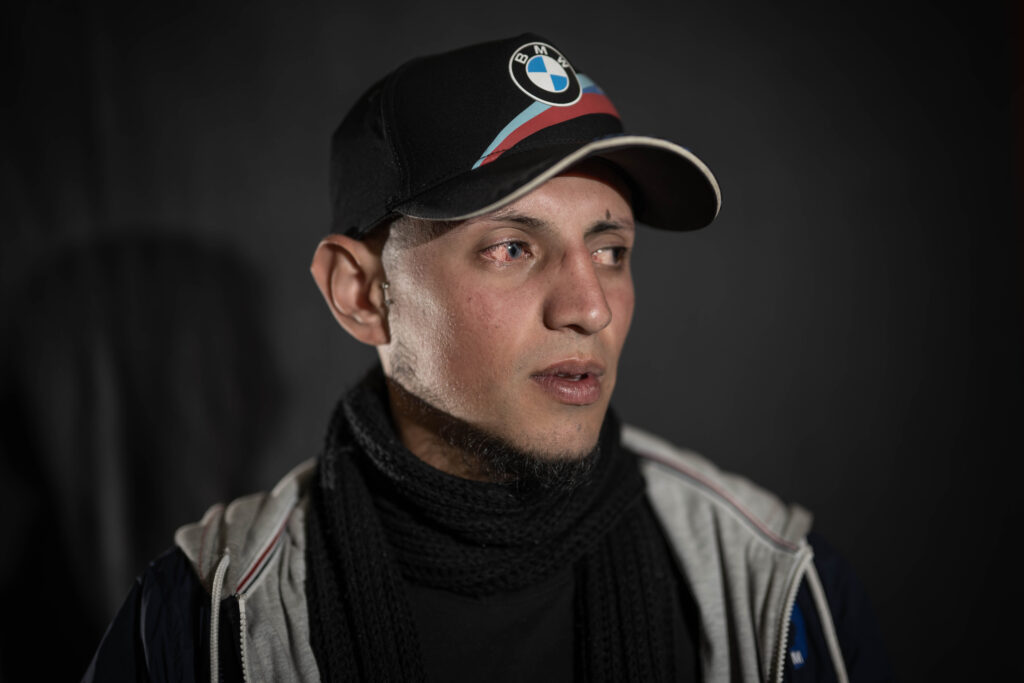
Mi caso, al principio fue complicado. Después de la cirugía me fue difícil porque no podía ver bien. Mi caso empezó el 26 de septiembre del año pasado (2021). Esa semana se estaba celebrando la semana por la paz acá en Bogotá. Yo hacía parte de un grupo, y junto con todo el grupo hicieron un partido contra la policía; una forma diferente de hacerle el combate a ellos.
Yo estaba en el partido con ellos, los acompañé; yo por distraerme, pasar la mente por otro lado, fui, jugué un rato y me fui.
Ese día un parcero me llamó para irnos a jugar al Parque Marruecos y nunca supimos qué iba a pasar. Estábamos jugando, haciendo actividad física, cuando de un momento a otro se empezaron a reunir unos pocos muchachos.
Obviamente yo hice parte de una Primera línea pero ese día yo estaba en otro cuento, y precisamente en el parque donde fui se armó una pequeña confrontación con los auxiliares. Después los muchachos volvieron al parque, ya después llegó el ESMAD.
En el momento en que entraron al parque atacando todo el mundo salió a correr, entonces yo también corrí. Cuando volteé un chico estaba enfrente de mí y cuando se agachó fue que me impactaron. Caí al piso y cuando me levanté salí corriendo por las escaleras del parque y fue ahí donde me caí y perdí el conocimiento.
Después me desperté y los muchachos me estaban haciendo fotos, videos, aunque yo les decía que no. Pero hicieron viral por TikTok el video de cuando estaba lesionado en el piso.
Estaba en el hospital, con un parcero y [tres agentes] vinieron a hacerme preguntas, que qué había pasado, que si estaba seguro que había sido la gente del ESMAD. Les dije «es obvio, porque es un golpe con una bala de goma». Igualmente había un policía que empezó como a mirarme, como a decirme «me lo voy a llevar si la caga».
Yo estaba como dormido, me despiertan con que «¿qué estabas haciendo?», y yo, «estoy medicado; lo que me están pidiendo es ilegal. No tengo porqué decir eso en este momento», pero se van un rato y vuelven.
Pero eso pasa con muchos. Por ejemplo, a las defensoras de derechos humanos que a mí me ayudaron las estuvieron llamando y diciendo: «ustedes defienden guerrilleros, luego las vamos a buscar», como para generarles un miedo para que no testifiquen las cosas que vieron.
Yo no había hecho nada malo. Sí fui parte de una Primera línea, pero ese día no estaba activo, ese día estaba en mi cuento aparte, andaba con mis amigos. La Primera línea sale en defensa del manifestante. No somos guerrilleros o terroristas, como nos han llamado. No somos eso, nosotros somos el escudo del pueblo.
Mi pregunta es: ¿por qué la mayoría de los chicos que han sido afectados ocularmente siempre es en el ojo derecho? Te pones a ver eso y ya tiene toda la intención de bajarle la cabeza al muchacho. Porque para ellos es un terrorista, es un guerrillero y es un objetivo militar.
Por el momento estoy bien. Sí me afecta un poco porque para buscar trabajo no en todos lados nos pueden recibir así. Ahorita estoy estudiando, terminando mi académico y los fines de semanas hago bachitas, o sea, los trabajitos que se puedan hacer.
Para mí el MOCAO también es una familia donde aprendí mucho cuando no sabía cuáles eran mis derechos. Al salir a la calle y pasar lo que me pasó me cambió: saber un poquito más del país y de mis derechos. Como despertar, decir «no más». Decir: «defiendo a mi pueblo y defiendo mis derechos».
Yo tengo una frase: «el que no la vive no la siente, parce».
Las peticiones al nuevo gobierno
A mediados de agosto de 2022, por medio de audios de Whatsapp, dos miembros del MOCAO hacen llegar a esta reportera sus peticiones para el gobierno que lleva menos de un mes en el cargo. Topo lo hace a título personal, mientras que Cristian aporta las propuestas oficiales del Movimiento.
Topo
De mi parte, como víctima, que no nos fallen, que cumplan con su palabra porque si no créanme que esto va a volver a ser un infierno y peor. Por eso lo único que yo le pido al gobierno es que sea un proceso bueno porque el temor de nosotros, el temor mío, es que vuelva a ocurrir lo que pasó el año pasado, y la verdad ya no quiero ver más sangre derramada sobre el asfalto.
Cristian
Desde el Movimiento Nacional de Víctimas de Trauma Ocular MOCAO, desde esta justanza social y política, en este nuevo gobierno hacemos una gran invitación a esta nueva agenda legislativa a que podamos trabajar mancomunadamente en tres propuestas puntuales:
- Las garantías de reparación y no repetición de este tipo de actos de lesa humanidad y de tratamientos de guerra en manifestaciones y protestas, que este tipo de actos en una manifestación jamás vuelvan a suceder en ninguna parte del territorio nacional.
- La construcción y la ejecución de una ruta de atención integral y vitalicia para todos los lesionados, víctimas de trauma ocular en todo el país porque somos más de 180, 200 personas no solo en el contexto del paro de 2021 sino en otros años anteriores. Que podamos trabajar articuladamente con los distintos representantes de los ministerios de Salud, Ministerio de Educación, Ministerio del Trabajo, para que podamos tener una atención integral y se puedan reivindicar los derechos que fueron vulnerados.
- Que desde la parte jurídica, la parte de justicia, los casos, las demandas de reparación directa puedan ser llevadas por la justicia penal ordinaria.
1 Grupo de manifestantes (casi siempre jóvenes) que se colocan adelante en las manifestaciones para proteger y cuidar al resto.
2 Se han respetado al máximo los testimonios originales de los chicos; sólo se han editado repeticiones de palabras o reiteraciones de ideas para una lectura más fácil.
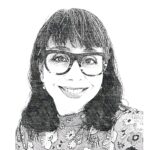
Irma Gallo es reportera y escritora. Además de Península 360 Press, ha colaborado con Letras Libres, Revista de la Universidad de México, Revista Lee Más Gandhi, Gatopardo, Revista Este País, Sin Embargo, El Universal, Newsweek en Español. Su libro más reciente es Cuando el cielo se pinta de anaranjado. Ser mujer en México (UANL/VF Agencia Literaria, 2020). Twitter: @irmagallo IG: @irmaevangelinagallo.
Esta nota se realizó con el apoyo de la organización Global Exchange en colaboración con el Centro de Estudios Socio Jurídicos Latinoamericanos —CESJUL— y Península 360 Press.
Te puede interesar: Colombia buscará «abrir puertas» para amplificar la voz de los vulnerables: CESJUL

